RANGE REPORTS: CHUBBY THE SKS-D, AND THE SEMI-NEW T/C FLINTLOCK
Our weather has finally improved, as has my time commitment at (ugh) work; I was finally able to snatch a few hours' worth of down time, enough so that I could take a half-day to get to the range and do a little shooting. It was much needed “pressure relief” from a not-so-pleasant few months.
Some time ago I was given a weird and somewhat rare SKS variant by a friend who recognized that he was dying, and has since passed on, may he rest in peace. It’s an "SKS-D," (sometimes also called a “Model 84”) or and “SKS-M”) the D meaning "detachable magazine." Now, detachable magazine conversions for SKS rifles are nothing new: there’s a sizeable cottage industry of converting them from the fixed 10-round box to a detachable magazine with a long tang (sometimes called a "duckbill") in the front to fit in the well where the fixed hinge goes. The SKS-D isn’t like that: it uses...AK-47 magazines. In theory any magazine that fits an AK will work in this rifle, and as we all know, AK magazines sometimes hold 30 or 40 or more rounds. I don’t personally have much use for a 30-round magazine, but they’ll work.
The SKS-D was a very short-lived model. Norinco produced it and several companies imported it for perhaps two years in very small numbers. It was an unsuccessful attempt to placate the Clintonazis as what became the 1992 "Assault Weapon" ban was being talked about. On the receiver it says, in very prominent letters, "SKS SPORTER" as if that were going to help much. It’s certainly suitable for sporting use, yes, as are all military rifles; but even though it came with a five-round magazine, and carried the euphemistic fig-leaf of being called a "sporter" it was included in the now-defunct ban. Even today, in some states (especially the People's
 It’s an ugly little bastard. It has a 16-1/2" barrel, and when I was give it, it was wearing a thumbhole stock so profoundly hideous even I couldn't stand it. It had to be the worst piece of construction-scrap-grade timber Norinco could find, and it was clearly whittled by convicts using dull pocket knives. It was so offensive to the eye that I bought a spare
It’s an ugly little bastard. It has a 16-1/2" barrel, and when I was give it, it was wearing a thumbhole stock so profoundly hideous even I couldn't stand it. It had to be the worst piece of construction-scrap-grade timber Norinco could find, and it was clearly whittled by convicts using dull pocket knives. It was so offensive to the eye that I bought a spare  military issue stock and had it suitably modified for the AK magazine adapter. I then painted the stock jet black and lacquer coated it. I will grant that it is not, even now, a thing of beauty, but it’s marginally less revolting than before. And like all SKS’s, it’s the sort of rifle that you can carry behind the seat of a truck (or in the open bed, for that matter) without affecting its reliability a whit. Like Mike Tyson, Chubby is ugly, tough, and dangerous to stand in front of.
military issue stock and had it suitably modified for the AK magazine adapter. I then painted the stock jet black and lacquer coated it. I will grant that it is not, even now, a thing of beauty, but it’s marginally less revolting than before. And like all SKS’s, it’s the sort of rifle that you can carry behind the seat of a truck (or in the open bed, for that matter) without affecting its reliability a whit. Like Mike Tyson, Chubby is ugly, tough, and dangerous to stand in front of.
Last Saturday was the first time I'd been able to get it out and play with it. I'd fiddled with it a bit and found some feeding issues. I therefore wanted to do a live-fire function check; I had some suspicions that the modified stock might have been the cause.
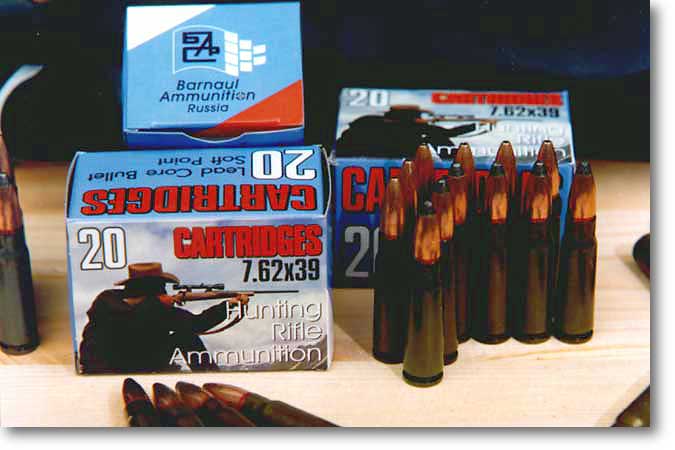 I had a bunch of 7.62x39 ammo on hand: some Russian-made Wolf and
I had a bunch of 7.62x39 ammo on hand: some Russian-made Wolf and 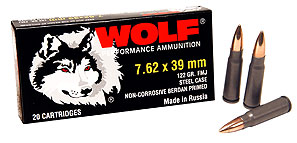 Barnaul in steel cases; a few steel-cased Chicom rounds I'd got with the rifle; and some reloads I made up with Remington brass. Along the way I'd also acquired a spare 10-round magazine.
Barnaul in steel cases; a few steel-cased Chicom rounds I'd got with the rifle; and some reloads I made up with Remington brass. Along the way I'd also acquired a spare 10-round magazine.
Inserting and removing magazines isn't easy. There's a lip on the front end of an AK magazine that catches in a depression in the bottom of the action. Chubby’s modification to use these consists of replacing the fixed magazine assembly with a sheet-metal box that has an  AK-style push-forward release in the rear. The box is held into the stock with screws and isn’t actually part of the action proper. When you put a magazine into this rifle, you have to insert it just right, catching the lip on the top of the sheet metal box. This is easier said than done, but after a few tries you get the “feel” of where it’s supposed to go. Once you’ve found the Sweet Spot, you slam the heck out of it on the bottom with your hand to seat it. Removing it is just as much of a PITA as inserting it. Maybe a little more so, as the magazine tended to hang up in the well.
AK-style push-forward release in the rear. The box is held into the stock with screws and isn’t actually part of the action proper. When you put a magazine into this rifle, you have to insert it just right, catching the lip on the top of the sheet metal box. This is easier said than done, but after a few tries you get the “feel” of where it’s supposed to go. Once you’ve found the Sweet Spot, you slam the heck out of it on the bottom with your hand to seat it. Removing it is just as much of a PITA as inserting it. Maybe a little more so, as the magazine tended to hang up in the well.
In the course of the testing, insertion and removal became a bit easier. This might have been due to my increasing familiarity with the gyrations needed, or perhaps to the sides of the magazine or the well becoming smoother with wear. I'm glad no one was shooting at me while I did a magazine change, though.
 Unlike the set-up in a conventional SKS there is no bolt hold-back function. Maybe this is because the modification didn’t allow enough room for a sliding catch, maybe it was another attempt to give this gun a “sporter” gloss, or maybe it was just because Norinco wanted to shave costs. Regardless of the reason, the bolt will close on an empty magazine, and someone unaware of this can get “SKS Thumb” pretty easily, as I did before I figured it out. Since it doesn’t lock open there's no way to load it from the top of the action. You have to take the magazine out. And of course there is no way to use stripper clips: there isn’t even a cut for one in the bolt carrier.
Unlike the set-up in a conventional SKS there is no bolt hold-back function. Maybe this is because the modification didn’t allow enough room for a sliding catch, maybe it was another attempt to give this gun a “sporter” gloss, or maybe it was just because Norinco wanted to shave costs. Regardless of the reason, the bolt will close on an empty magazine, and someone unaware of this can get “SKS Thumb” pretty easily, as I did before I figured it out. Since it doesn’t lock open there's no way to load it from the top of the action. You have to take the magazine out. And of course there is no way to use stripper clips: there isn’t even a cut for one in the bolt carrier.
For all its defects and clumsiness, it shot surprisingly well. I had several failures to feed at first, mainly using the brass case reloads. The bolt is very violent in action and it will actually bend a cartridge if, in coming forward into battery, it catches the case at just the right place. I’ve seen rimfire autoloaders do this, but I’ve never had it happen with a centerfire rifle before. The problem seemed to be caused by the rear end of the case not coming up far enough to get caught by the bolt. The moving bolt starts stripping the round out by grabbing it in the middle; the case emerges at the wrong angle for the feed ramp, and gets caught between the bolt face and the breech face. This also might have been a wear-in problem; or it might have been due to a weak magazine spring failing to push the carrier up a millimeter higher, but I don't think so. It was somewhat inconsistent: sometimes several rounds would feed flawlessly, and then one would hang up. A weak spring would likely produce consistent jams. But the sides of the carrier where they bear against the magazine box might well have been rough and needed break-in. The 10-round magazine seemed much more reliable than the 5-round one, and by the end of the session was feeding quite smoothly with the steel-case Russian stuff. By then I'd shot off all the brass cases.
 The Wolf ammo is loaded with FMJ bullets. It’s clearly Russian military issue in a commercial box. Say what you will about the Rooshians, they have adapted to the end of the
The Wolf ammo is loaded with FMJ bullets. It’s clearly Russian military issue in a commercial box. Say what you will about the Rooshians, they have adapted to the end of the
The Wolf ammo cycled reasonably well, but did occasionally hang. However, Chubby really seemed to like the
This isn't a target rifle, but I was satisfied with the results of the session in which I burned up 80 rounds or so. As I was driving to the range I realized I'd forgotten to bring along the tools needed to adjust the front sight for windage and elevation, but in the end I didn't need them. The sights were bang on at 50 yards for elevation and windage using a 6-o'clock hold. Nearly every bullet went into the black on a Shoot-N-See target at that range. Recoil was negligible. Recovering the sight picture in rapid fire was fast and easy; whatever other flaws the SKS may have, it has pretty decent open sights, a nice square notch and a squared off front post.
I started plinking at rocks with it, and old clay targets that had been set up on the ground by someone. Anything within 200 yards that's 4" in diameter or more is toast: I could certainly hit a deer with it over that range, every time, and in the woods this Fall it will be pretty much perfectly certain that any deer I see I can hit.
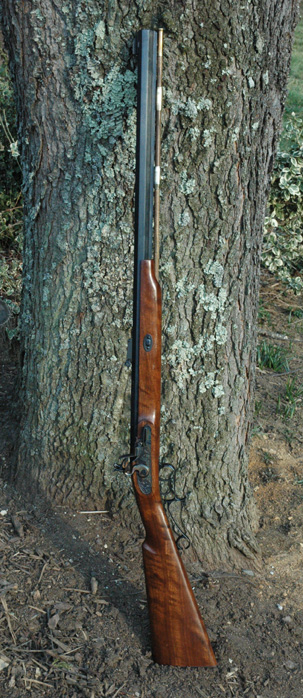 On to the flintlock...a few weeks ago I got a deal on a Thompson/Center rifle that was far too good to pass up. It was pretty close to new condition and half the price of new. It’s a hybrid of the Renegade and the Hawken, which differ only in ornamentation. Mine has a Renegade stock and lock with iron furniture, fitted with a Hawken barrel and its brass trimmings. A plus was that it was a .54. I have a new Englander .54 which has taken seven deer so far, so I already had all the components and most of the accessories I needed, though not all.
On to the flintlock...a few weeks ago I got a deal on a Thompson/Center rifle that was far too good to pass up. It was pretty close to new condition and half the price of new. It’s a hybrid of the Renegade and the Hawken, which differ only in ornamentation. Mine has a Renegade stock and lock with iron furniture, fitted with a Hawken barrel and its brass trimmings. A plus was that it was a .54. I have a new Englander .54 which has taken seven deer so far, so I already had all the components and most of the accessories I needed, though not all.
I have a lot of experience with percussion rifles, and much of that translates to using a flinter; but though I'd shot flintlocks casually from time time in Hunter Ed training or those belonging to someone else, I’d never actually“driven” one myself. My first session taught me that it’s clearly going to take some re-adjustment of my mantras to hunt with it successfully.
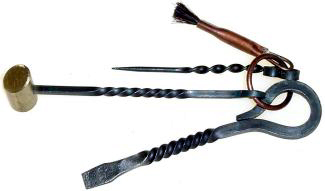 I sought advice from the BP Gurus at Track of the Wolf and The Gun Works from whom I ordered some flints and other odds and ends, mostly tools. A flintlock rifle requires some kit that I simply didn't have, because it isn’t needed for a percussion rifle. I ended up with a "Flinter's Tool Kit," consisting of several wrought iron items on a ring: a pan brush, a vent pick that looks like a toothpick and is much larger than the one for a percussion nipple, a little
I sought advice from the BP Gurus at Track of the Wolf and The Gun Works from whom I ordered some flints and other odds and ends, mostly tools. A flintlock rifle requires some kit that I simply didn't have, because it isn’t needed for a percussion rifle. I ended up with a "Flinter's Tool Kit," consisting of several wrought iron items on a ring: a pan brush, a vent pick that looks like a toothpick and is much larger than the one for a percussion nipple, a little  brass hammer to knap the flint, and a screwdriver. Along with that two dozen flints of two types, black English hand-knapped and
brass hammer to knap the flint, and a screwdriver. Along with that two dozen flints of two types, black English hand-knapped and
I spent some time reading up on the technology, chatting with Track, and puffing a few pans of priming powder now and then to get the hang of it. After doing that and after the first trip to the range, it’s quite clear to me why the invention of the percussion lock swept the flintlock off the field in a matter of a few years.
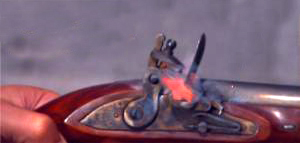 The T/C is a well-made gun with a good lock, and though it’s mass-produced, I would venture to say that in terms of mechanical reliability and durability, it’s better than anything ever made by an 18th Century custom gunmaker, however respected. Modern CNC machining and investment casting simply can’t be duplicated by hand work, let alone excelled. That said, even with the best lock, old or new, misfires are part of the game. This is true with percussion guns (as I have found to my sorrow more than once) but they’re far less likely to misfire than flintlocks are by nature. On a fine, clear, dry day, with a good lock, a sharp flint, and perfect powder, a flintlock will misfire 1 time in 10, give or take a few. The common expression, "a flash in the pan," meaning something that promises a lot but doesn't deliver, comes from the flintlock era. The powder in the pan may ignite but if it doesn't set the main charge off, you have...a flash in the pan, and that's it.
The T/C is a well-made gun with a good lock, and though it’s mass-produced, I would venture to say that in terms of mechanical reliability and durability, it’s better than anything ever made by an 18th Century custom gunmaker, however respected. Modern CNC machining and investment casting simply can’t be duplicated by hand work, let alone excelled. That said, even with the best lock, old or new, misfires are part of the game. This is true with percussion guns (as I have found to my sorrow more than once) but they’re far less likely to misfire than flintlocks are by nature. On a fine, clear, dry day, with a good lock, a sharp flint, and perfect powder, a flintlock will misfire 1 time in 10, give or take a few. The common expression, "a flash in the pan," meaning something that promises a lot but doesn't deliver, comes from the flintlock era. The powder in the pan may ignite but if it doesn't set the main charge off, you have...a flash in the pan, and that's it.
“
As the frizzen face gets scarred up by strikes from the flint, there's less and less contact between flint and steel. So even when the flint is sharp, if the frizzen needs cleaning or touch-up you get a smaller spark production. The answer is...sandpaper, one more damned thing to remember to bring along in the kit. I tried this theory out, and sure enough, I found that if I polished the frizzen face with 150-grit and then 220-grit paper, I could count on getting more sparks. Cleaning and/or sanding the frizzen, plus knapping the flint seems to give me about a 90% chance of a good spark. Eventually the frizzen wears out, or gets sanded too thin, and it has to be replaced or re-hardened.
So: in order to as sure as you can be that the beast will bite when you pull the trigger, you have to constantly be fiddling with it. Sharpening, setting and re-setting the flint, cleaning and the polishing the frizzen, pricking the vent, yada, yada, yada...and even then you're never absolutely SURE it's going to go off.
IF the powder in the pan isn't damp; IF the powder hasn't sifted out of the pan even with the cover closed (as it tends to do); IF the powder train isn't too large, thus producing a "fuse" effect rather than a flash; IF there's enough powder to make a big enough flame to set off the main charge; IF the vent isn't clogged; IF the powder in the breech is in fact right up to the vent hole, and IF nothing else gets in the way, the gun will go off. Ninety percent of the time.

Crude though it is, a couple of hours of shooting made me realize quite forcefully why flintlock technology was well suited to the opening of the North American continent to settlement. The locks are primitive devices easily repaired by anyone with basic tools and skills.
Thus prepped, I loaded the gun with 90 grains FFg, using a round ball with a patch and an under-ball wool wad. This is the same load used in my percussion New Englander. I primed the pan with about 8 grains of FFFg (didn't have any FFFFg, it isn’t available locally and I have to track some down; I’m told it’s much more suited to priming use).
It has a set trigger, which frankly I find a little scary. For targets it's fine, but in the woods I think a set trigger is asking for trouble. It can be fired with just the front trigger but the pull is very hard. T/C is supposed to be able to fit a single trigger assembly on these rifles at modest cost and I likely will do that for hunting use.
My first shot went low and right. The second shot did the same, hitting about an inch away or a bit less. That looked very promising! I fiddled with the sights and shot #3 went spang into the middle of the bullseye. Two more shots went off to the left but still were closely grouped.
My friend Rick (who was shooting a scoped in-line that would shave hair off a gnat's ass, and never misfires because he uses 209 primers, 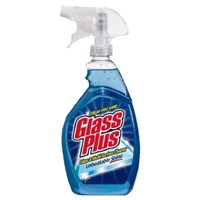 damn it) suggested that in his flinter he’d found that fouling caused it to shoot off center, so I applied another trick one of my BP mentors told me about. “Glass Plus” liquid cleaner is just about the best field BP solvent there is, much better than plain water. I started swabbing between shots. The patches came out with some of the grisliest fouling imaginable on them, but after a wipe and a dry patch, sure enough, my hits came back in where they should have been.
damn it) suggested that in his flinter he’d found that fouling caused it to shoot off center, so I applied another trick one of my BP mentors told me about. “Glass Plus” liquid cleaner is just about the best field BP solvent there is, much better than plain water. I started swabbing between shots. The patches came out with some of the grisliest fouling imaginable on them, but after a wipe and a dry patch, sure enough, my hits came back in where they should have been.
I put two more shots in the bull, an inch and a half apart. I was pleased enough with the results that I called it quits, not wanting to ruin my average, and also because I was getting to smell like a stable yard. I'll hunt with this rifle during the 2007 BP season, if the weather is good. I doubt I could make it go off in the rain!
| HUNTING | GUNS | DOGS |
| FISHING & BOATING | TRIP REPORTS | MISCELLANEOUS ESSAYS |
| CONTRIBUTIONS FROM OTHER WRITERS|
| RECIPES |POLITICS |